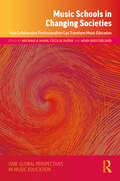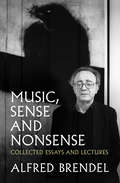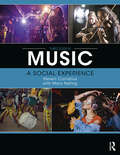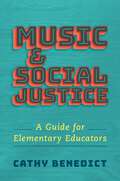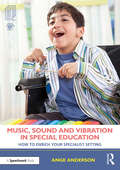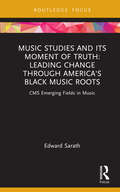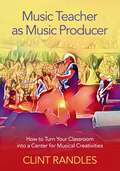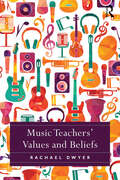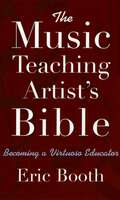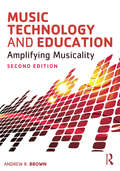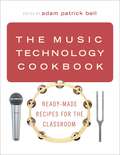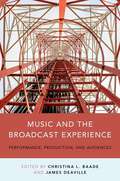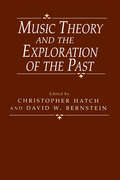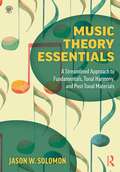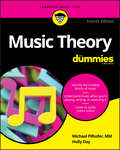- Table View
- List View
Music Schools in Changing Societies: How Collaborative Professionalism Can Transform Music Education (ISME Series in Music Education)
Music Schools in Changing Societies addresses the need to understand instrumental and vocal pedagogy beyond the individual sphere of teacher–student interactions and psychological phenomena, focusing instead on the wider sociocultural, spatial, and institutional contexts of music education. Viewing music education through the perspective of collaboration, the book focuses on the context of European music schools, which have developed a central role in publicly funded educational and cultural systems. The authors demonstrate that multilevel collaboration is a vital part of how music educators and the schools where they work can respond to wider societal concerns in ways that improve educational quality. Presenting examples of innovative practices and collaborative settings from twelve European countries, this book offers new and inspiring perspectives on how music schools can support the transformation towards collaborative professionalism in instrumental and vocal music education. With contributions from a wide range of researchers and professional educators, the book shows how a collaborative approach to music education can address major policy issues such as inclusion, democracy, and sustainability. Addressing current institutional and curricular challenges, Music Schools in Changing Societies presents a unique outlook on how music schools in contemporary societies can survive and thrive in times of change.
Music, Sense and Nonsense: Collected Essays and Lectures
by Alfred BrendelAlfred Brendel, one of the greatest pianists of our time, is renowned for his masterly interpretations of Haydn, Mozart, Beethoven, Schubert and Liszt, and has been credited with rescuing from oblivion the piano music of Schubert's last years. Far from having merely one string to his bow, however, Brendel is also one of the world's most remarkable writers on music - possessed of the rare ability to bring the clarity and originality of expression that characterised his performances to the printed page. The definitive collection of his award-winning writings and essays, Music, Sense and Nonsense combines all of his work originally published in his two classic books, Musical Thoughts and Afterthoughts and Music Sounded Out, along with significant new material on a lifetime of recording, performance habits and reflections on life and art. As well as providing stimulating reading, this new edition provides a unique insight into the exceptional mind of one of the outstanding musicians of the twentieth and twenty-first centuries. Whether discussing Bach or Beethoven, Schubert or Schoenberg, Brendel's reflections are illuminating and challenging, a treasure for the specialist and the music lover alike.
Music: A Social Experience
by Steven Cornelius Mary NatvigBy taking a thematic approach to the study of music appreciation, Music: A Social Experience, Third Edition demonstrates how music reflects and deepens both individual and cultural understandings. Musical examples are presented within universally experienced social frameworks (ethnicity, gender, spirituality, love, and more) to help students understand how music reflects and advances human experience. Students engage with multiple genres (Western art music, popular music, and world music) through lively narratives and innovative activities. A companion website features streaming audio and instructors' resources. The third edition includes: A chapter on Black American music A revised and developed chapter on gender and sexuality A dozen additional Listening Guides, with an emphasis on contemporary popular music Over 100 new full-color images Updated teacher and student resources on the book’s companion website Expanded content throughout, highlighting the social, cultural, and technological changes since publication of the previous edition The culmination of thirty years of experimentation in the music appreciation classroom, this third edition of Music: A Social Experience continues to empower lifelong musical learning by engaging students and readers on their own terms.
MUSIC & SOCIAL JUSTICE C: A Guide for Elementary Educators
by Cathy BenedictIn this book author Cathy Benedict challenges and reframes traditional ways of addressing many of the topics we have come to think of as social justice. Offering practical suggestions for helping both teachers and students think philosophically (and thus critically) about the world around them, each chapter engages with important themes through music making and learning as it presents scenarios, examples of dialogue with students, unit ideas and lesson plans geared toward elementary students (ages 6-14). Taken-for-granted subjects often considered beyond the understanding of elementary students such as friendship, racism, poverty, religion, and class are addressed and interrogated in such a way that honours the voice and critical thinking of the elementary student. Suggestions are given that help both teachers and students to pause, reflect and redirect dialogue with questions that uncover bias, misinformation and misunderstandings that too often stand in the way of coming to know and embracing difference. Guiding questions, which anchor many curricular mandates, are used throughout in order to scaffold critical and reflective thinking beginning in the earliest grades of elementary music education. Where does social justice reside? Whose voice is being heard and whose is being silenced? How do we come to think of and construct poverty? How is it that musics become used the way they are used? What happens to songs initially intended for socially driven purposes when their significance is undermined? These questions and more are explored encouraging music teachers to embrace a path toward socially just engagements at the elementary and middle school levels.
Music, Sound and Vibration in Special Education: How to Enrich Your Specialist Setting
by Ange AndersonThis book provides practical guidance on how to successfully incorporate music, sound and vibration into your special school, exploring the rich benefits that musical opportunities offer for children with physical, mental health and learning disabilities. Music has been shown to improve mood, lift depression, improve blood flow and even ease pain, whilst musical interventions can encourage communication and enable relaxation. This book explores the physical, cognitive and mental health benefits of music use in special schools, introducing therapies and innovations that can be adapted for use in your own specialist setting. Key features include: • Chapters exploring a range of music therapies and technologies that allow all students to access the benefits of music, sound and vibration, from one-to-one therapeutic music sessions to vibro-acoustic therapy and sing and sign • Case studies and anecdotes showcasing the innovative ways that special schools are using music, and providing concrete examples of how to deliver, record and access music provision • Photocopiable policies, risk assessments and links to useful resources Written by an author with a wealth of experience in special education, this book is essential reading for all those working in specialist settings or with children with SEND.
Music, Sound and Vibration in Special Education: How to Enrich Your Specialist Setting
by Ange AndersonThis book provides practical guidance on how to successfully incorporate music, sound and vibration into your special school, exploring the rich benefits that musical opportunities offer for children with physical, mental health and learning disabilities. Music has been shown to improve mood, lift depression, improve blood flow and even ease pain, whilst musical interventions can encourage communication and enable relaxation. This book explores the physical, cognitive and mental health benefits of music use in special schools, introducing therapies and innovations that can be adapted for use in your own specialist setting. Key features include: • Chapters exploring a range of music therapies and technologies that allow all students to access the benefits of music, sound and vibration, from one-to-one therapeutic music sessions to vibro-acoustic therapy and sing and sign • Case studies and anecdotes showcasing the innovative ways that special schools are using music, and providing concrete examples of how to deliver, record and access music provision • Photocopiable policies, risk assessments and links to useful resources Written by an author with a wealth of experience in special education, this book is essential reading for all those working in specialist settings or with children with SEND.
Music Studies and Its Moment of Truth: CMS Emerging Fields in Music (CMS Emerging Fields in Music)
by Edward SarathMusic Studies and Its Moment of Truth: Leading Change through America’s Black Music Roots presents a new framework for racial justice discourse in the context of music studies and education. Centering on Black American Music, the book issues challenges to both the conventional music studies paradigm and decades-old reform efforts.While Black American Music ranks high among America’s contributions to world culture, and offers musicians powerful tools for musical practice and understanding, this musical legacy remains remarkably marginalized even in activist conversations. The author argues that this reflects lingering and unexamined racist patterns that persist even among the most fervent voices for anti-racist interventions, and addresses the need for a higher-order activist framework within music studies.Delving further into the transformative changes needed to pursue racial justice, the short pieces collected in this book discuss topics including a shift from multicultural ideology to a transcultural model of musical pluralism, analysis of the multi-tiered nature of musical racism, the whitewashing of music studies activism, K-12 music teacher education as the locus for paradigmatic change and the potential for a transformed model of music studies to catalyze an overarching revolution in creativity and consciousness in both education and society at large. Critiquing the failures of progressive reform efforts and conventional reaction, this book argues that major changes are needed to the discourse on racism in music studies, and envisions new paradigms for the future.
Music Studies and Its Moment of Truth: CMS Emerging Fields in Music (CMS Emerging Fields in Music)
by Edward SarathMusic Studies and Its Moment of Truth: Leading Change through America’s Black Music Roots presents a new framework for racial justice discourse in the context of music studies and education. Centering on Black American Music, the book issues challenges to both the conventional music studies paradigm and decades-old reform efforts.While Black American Music ranks high among America’s contributions to world culture, and offers musicians powerful tools for musical practice and understanding, this musical legacy remains remarkably marginalized even in activist conversations. The author argues that this reflects lingering and unexamined racist patterns that persist even among the most fervent voices for anti-racist interventions, and addresses the need for a higher-order activist framework within music studies.Delving further into the transformative changes needed to pursue racial justice, the short pieces collected in this book discuss topics including a shift from multicultural ideology to a transcultural model of musical pluralism, analysis of the multi-tiered nature of musical racism, the whitewashing of music studies activism, K-12 music teacher education as the locus for paradigmatic change and the potential for a transformed model of music studies to catalyze an overarching revolution in creativity and consciousness in both education and society at large. Critiquing the failures of progressive reform efforts and conventional reaction, this book argues that major changes are needed to the discourse on racism in music studies, and envisions new paradigms for the future.
Music Teacher as Music Producer: How to Turn Your Classroom into a Center for Musical Creativities
by Clint RandlesNever has there been such an exciting time to be a music teacher. Band, choir, and orchestra are ubiquitous in schools and have come to be known as the primary mode that students experience music at the secondary level. Similarly, elementary school classrooms feature approaches by Orff, Kodaly, Dalcroze, and Music Learning Theory, among a host of others. But, what is next? In this enlightening guide, author Clint A. Randles provides music educators with the practical tools to turn their classrooms into student production studios. Addressing everything from a new conceptualization of the physical classroom space to the cables and other audio equipment no music educator should be without, Randles puts creativity, technology, recording arts, songwriting, music production, and live performance at the center of music classrooms.
Music Teacher as Music Producer: How to Turn Your Classroom into a Center for Musical Creativities
by Clint RandlesNever has there been such an exciting time to be a music teacher. Band, choir, and orchestra are ubiquitous in schools and have come to be known as the primary mode that students experience music at the secondary level. Similarly, elementary school classrooms feature approaches by Orff, Kodaly, Dalcroze, and Music Learning Theory, among a host of others. But, what is next? In this enlightening guide, author Clint A. Randles provides music educators with the practical tools to turn their classrooms into student production studios. Addressing everything from a new conceptualization of the physical classroom space to the cables and other audio equipment no music educator should be without, Randles puts creativity, technology, recording arts, songwriting, music production, and live performance at the center of music classrooms.
Music Teachers' Values and Beliefs
by Rachael DwyerIn Music Teachers' Values and Beliefs, Dwyer investigates the relationships between teachers, learners and music in music classrooms. Using Bourdieu's concepts of habitus and doxa as an interpretive lens, the book explores the values and beliefs of four music teachers, depicted in richly detailed narratives. The narratives are contextualised through the examination of traditions of music and contemporary approaches. In the past, music education has been shaped by elitist tendencies regarding the types of music worthy of study, the ways in which music should be learnt, and the purpose of such learning. Contemporary approaches to music education have enacted significant change in some regions and systems, while others have been slower to leave behind deeply entrenched values, beliefs and practices. These approaches have been blamed for low rates of participation and engagement in school music education, despite the fact that the majority of young people listen to and enjoy music outside of school. This innovative book provides music education researchers and practitioners with a new understanding of the impact of teachers' personal values, beliefs and experiences of music and music education on classroom practice, and the impact this has on students' experiences of music education.
Music Teachers' Values and Beliefs
by Rachael DwyerIn Music Teachers' Values and Beliefs, Dwyer investigates the relationships between teachers, learners and music in music classrooms. Using Bourdieu's concepts of habitus and doxa as an interpretive lens, the book explores the values and beliefs of four music teachers, depicted in richly detailed narratives. The narratives are contextualised through the examination of traditions of music and contemporary approaches. In the past, music education has been shaped by elitist tendencies regarding the types of music worthy of study, the ways in which music should be learnt, and the purpose of such learning. Contemporary approaches to music education have enacted significant change in some regions and systems, while others have been slower to leave behind deeply entrenched values, beliefs and practices. These approaches have been blamed for low rates of participation and engagement in school music education, despite the fact that the majority of young people listen to and enjoy music outside of school. This innovative book provides music education researchers and practitioners with a new understanding of the impact of teachers' personal values, beliefs and experiences of music and music education on classroom practice, and the impact this has on students' experiences of music education.
The Music Teaching Artist's Bible: Becoming a Virtuoso Educator
by Eric BoothWhen the artist moves into the classroom or community to educate and inspire students and audience members, this is Teaching Artistry. It is a proven means for practicing professional musicians to create a successful career in music, providing not only necessary income but deep and lasting satisfaction through engaging people in learning experiences about the arts. Filled with practical advice on the most critical issues facing the music teaching artist today--from economic and time-management issues of being a musician and teacher to communicating effectively with students--The Music Teaching Artist's Bible uncovers the essentials that every musician needs in order to thrive in this role. Author Eric Booth offers both inspiration and how-to, step-by-step guidance in this truly comprehensive manual that music teaching artists will turn to again and again. The book also includes critical information on becoming a mentor, succeeding in school environments, partnering with other teaching artists, advocating for music and arts education, and teaching private lessons. The Music Teaching Artist's Bible helps practicing and aspiring teaching artists gain the skills they need to build new audiences, improve the presence of music in schools, expand the possibilities of traditional and educational performances, and ultimately make their lives as an artists even more satisfying and fulfilling.
The Music Teaching Artist's Bible: Becoming a Virtuoso Educator
by Eric BoothWhen the artist moves into the classroom or community to educate and inspire students and audience members, this is Teaching Artistry. It is a proven means for practicing professional musicians to create a successful career in music, providing not only necessary income but deep and lasting satisfaction through engaging people in learning experiences about the arts. Filled with practical advice on the most critical issues facing the music teaching artist today--from economic and time-management issues of being a musician and teacher to communicating effectively with students--The Music Teaching Artist's Bible uncovers the essentials that every musician needs in order to thrive in this role. Author Eric Booth offers both inspiration and how-to, step-by-step guidance in this truly comprehensive manual that music teaching artists will turn to again and again. The book also includes critical information on becoming a mentor, succeeding in school environments, partnering with other teaching artists, advocating for music and arts education, and teaching private lessons. The Music Teaching Artist's Bible helps practicing and aspiring teaching artists gain the skills they need to build new audiences, improve the presence of music in schools, expand the possibilities of traditional and educational performances, and ultimately make their lives as an artists even more satisfying and fulfilling.
Music Technology and Education: Amplifying Musicality
by Andrew BrownMusic Technology in Education lays out the principles of music technology and how they can be used to enhance musical teaching and learning in primary and secondary education. Previously published as Computers in Music Education, this second edition has been streamlined to focus on the needs of today’s music education student. It has been completely updated to reflect mobile technologies, social networks, rich media environments, and other technological advances. Topics include: Basic audio concepts and recording techniques Enhanced music instruction with interactive systems, web-based media platforms, social networking, and musicianship software Administration and management of technology resources Distance education and flexible learning Music Technology in Education provides a strong theoretical and philosophical framework for examining the use of technology in music education while outlining the tools and techniques for implementation in the classroom. Reflective Questions, Teaching Tips, and Suggested Tasks link technology with effective teaching practice. The companion website provides resources for deeper investigation into the topics covered in each chapter, and includes an annotated bibliography, website links, tutorials, and model projects.
Music Technology and Education: Amplifying Musicality
by Andrew BrownMusic Technology in Education lays out the principles of music technology and how they can be used to enhance musical teaching and learning in primary and secondary education. Previously published as Computers in Music Education, this second edition has been streamlined to focus on the needs of today’s music education student. It has been completely updated to reflect mobile technologies, social networks, rich media environments, and other technological advances. Topics include: Basic audio concepts and recording techniques Enhanced music instruction with interactive systems, web-based media platforms, social networking, and musicianship software Administration and management of technology resources Distance education and flexible learning Music Technology in Education provides a strong theoretical and philosophical framework for examining the use of technology in music education while outlining the tools and techniques for implementation in the classroom. Reflective Questions, Teaching Tips, and Suggested Tasks link technology with effective teaching practice. The companion website provides resources for deeper investigation into the topics covered in each chapter, and includes an annotated bibliography, website links, tutorials, and model projects.
The Music Technology Cookbook: Ready-Made Recipes for the Classroom
Featuring 56 lessons by 49 music technology experts from around the world, The Music Technology Cookbook is an all-in-one guide to the world of music technology, covering topics like: composition (with digital audio workstations such as Ableton, Soundtrap, GarageBand); production skills such as recording, editing, and equalization; creating multimedia (ringtones, soundscapes, audio books, sonic brands, jingles); beatmaking; DJing; programming (Minecraft, Scratch, Sonic Pi, P5.js); and, designing instruments (MaKey MaKey). Each lesson tailored for easy use and provides a short description of the activity, keywords, materials needed, teaching context of the contributing author, time required, detailed instructions, modifications for learners, learning outcomes, assessment considerations, and recommendations for further reading. Music educators will appreciate the book's organization into five sections--Beatmaking and Performance; Composition; Multimedia and Interdisciplinary; Production; Programming--which are further organized by levels beginner, intermediate, and advanced. Written for all educational contexts from community organizations and online platforms to universities and colleges, The Music Technology Cookbook offers a recipe for success at any level.
MUSIC TECHNOLOGY COOKBOOK C: Ready-Made Recipes for the Classroom
by Adam Patrick BellFeaturing 56 lessons by 49 music technology experts from around the world, The Music Technology Cookbook is an all-in-one guide to the world of music technology, covering topics like: composition (with digital audio workstations such as Ableton, Soundtrap, GarageBand); production skills such as recording, editing, and equalization; creating multimedia (ringtones, soundscapes, audio books, sonic brands, jingles); beatmaking; DJing; programming (Minecraft, Scratch, Sonic Pi, P5.js); and, designing instruments (MaKey MaKey). Each lesson tailored for easy use and provides a short description of the activity, keywords, materials needed, teaching context of the contributing author, time required, detailed instructions, modifications for learners, learning outcomes, assessment considerations, and recommendations for further reading. Music educators will appreciate the book's organization into five sections--Beatmaking and Performance; Composition; Multimedia and Interdisciplinary; Production; Programming--which are further organized by levels beginner, intermediate, and advanced. Written for all educational contexts from community organizations and online platforms to universities and colleges, The Music Technology Cookbook offers a recipe for success at any level.
MUSIC & THE BROADCAST EXPERIENCE C: Performance, Production, and Audiences
by Christina L. Baade and James DeavilleMusic and the Broadcast Experience explores the complex ways in which music and broadcasting have developed together throughout the twentieth and into the twenty-first centuries. It brings into dialogue researchers working in media and music studies; explores and develops crucial points of contact between studies of music in radio and music in television; and investigates the limits, persistence, and extensions of music broadcasting in the Internet era. The book presents a series of case studies that address key moments and concerns in music broadcasting, past and present, written by leading scholars in the field, who hail from both media and music studies. Unified by attentiveness both to musical sound and meaning and to broadcasting structures, practices, audiences, and discourses, the chapters in this collection address the following topics: the role of live orchestral concerts and opera in the early development of radio and their relation to ideologies of musical uplift; the relation between production culture, music, and television genre; the function of music in sponsored radio during the 1930s; the fortunes of musical celebrity and artistic ambition on television; questions of music format and political economy in the development of online radio; and the negotiation of space, community, and participation among audiences, online and offline, in the early twenty-first century. The collection's ultimate aim is to explore the usefulness and limitations of broadcasting as a concept for understanding music and its cultural role, both historically and today.
Music, the Market, and the Marvellous: Parisian Féerie, 1864-1900 (British Academy Monographs)
by Tommaso SabbatiniMusic, the Market, and the Marvellous examines féerie, the French fairy play, in the last third of the nineteenth century. It is among the first book-length studies on the genre, the first in a language other than French, and the first from a musicological perspective. Sabbatini demonstrates that, contrary to conventional wisdom, féerie was still thriving during the fin de siècle, giving rise to innovations such as composerly féerie and scientific féerie. The plays, the theatre industry, and urban geography are discussed together, as befits a commercial genre where the marvellous was shaped by the market. Recovering this forgotten ^—^ but once hugely influential ^—^ repertoire provides an occasion to rethink generic taxonomies of Parisian theatre and the ontology of nineteenth-century 'popular' theatre.
Music Theory and the Exploration of the Past
by Christopher Hatch David W. BernsteinIn recent decades, increased specialization has sharply separated music theory from historical musicology. Music Theory and the Exploration of the Past brings together a group of essays—written by theorists and musicologists—that seek to bridge this gap. This collection shows that music theory can join forces with historical musicology to produce a more humanistic form of musical scholarship. In nineteen essays dealing with musical theories from the twelfth to the twentieth century, two recurring themes emerge. One is the need to understand the historical circumstances of the writing and reception of theory, a humanistic approach that gives theory a place within social and intellectual history. The other is the advantages of applying contemporaneous theory to the music of a given period, thus linking theory to the history of musical styles and structures. The periods given principal attention in these essays are the Renaissance, the years around 1800, and the twentieth century. Abundantly illustrated with musical examples, Music Theory and the Exploration of the Past offers models of new practical applications of theory to the analysis of music. At the same time, it raises the broader question of how historical knowledge can deepen the understanding of an art and of systematic writings about that art.
Music Theory Essentials: A Streamlined Approach to Fundamentals, Tonal Harmony, and Post-Tonal Materials
by Jason W. SolomonMusic Theory Essentials offers an antidote to music theory textbooks that are overly long and dense. Focusing on the essentials, this text provides a clear-cut guide to the key concepts of music theory. Beginning with no assumptions about music theory knowledge, the book covers the core elements of music fundamentals, diatonic and chromatic harmony, post-tonal theory, and popular music in a single concise volume. Emphasizing critical thinking skills, this book guides students through conceptualizing musical concepts and mastering analytic techniques. Each chapter concludes with a selection of applications designed to enhance engagement: Exercises allow students to apply and practice the skills and techniques addressed in the chapter. Brain Teasers challenge students to expand their musical understanding by thinking outside the box. Exploring Music offers strategies for students to apply learned concepts to the music they are currently learning or listening to. Thinking Critically encourages students to think more deeply about music by solving problems and identifying and challenging assumptions. A companion website provides answers to book exercises, additional downloadable exercises, and audio examples. Straightforward and streamlined, Music Theory Essentials is a truly concise yet comprehensive introduction to music theory that is accessible to students of all backgrounds.
Music Theory Essentials: A Streamlined Approach to Fundamentals, Tonal Harmony, and Post-Tonal Materials
by Jason W. SolomonMusic Theory Essentials offers an antidote to music theory textbooks that are overly long and dense. Focusing on the essentials, this text provides a clear-cut guide to the key concepts of music theory. Beginning with no assumptions about music theory knowledge, the book covers the core elements of music fundamentals, diatonic and chromatic harmony, post-tonal theory, and popular music in a single concise volume. Emphasizing critical thinking skills, this book guides students through conceptualizing musical concepts and mastering analytic techniques. Each chapter concludes with a selection of applications designed to enhance engagement: Exercises allow students to apply and practice the skills and techniques addressed in the chapter. Brain Teasers challenge students to expand their musical understanding by thinking outside the box. Exploring Music offers strategies for students to apply learned concepts to the music they are currently learning or listening to. Thinking Critically encourages students to think more deeply about music by solving problems and identifying and challenging assumptions. A companion website provides answers to book exercises, additional downloadable exercises, and audio examples. Straightforward and streamlined, Music Theory Essentials is a truly concise yet comprehensive introduction to music theory that is accessible to students of all backgrounds.
Music Theory For Dummies
by Michael Pilhofer Holly DayTune in to how music really works Whether you’re a student, a performer, or simply a fan, this book makes music theory easy, providing you with a friendly guide to the concepts, artistry, and technical mastery that underlie the production of great music. You’ll quickly become fluent in the fundamentals of knocking out beats, reading scores, and anticipating where a piece should go, giving you a deeper perspective on the works of others — and bringing an extra dimension to your own. Tracking to a typical college-level course, Music Theory For Dummies breaks difficult concepts down to manageable chunks and takes into account every aspect of musical production and appreciation — from the fundamentals of notes and scales to the complexities of expression and instrument tone color. It also examines the latest teaching techniques — all the more important as the study of music, now shown to provide cognitive and learning benefits for both children and adults, becomes more prevalent at all levels. Master major and minor scales, intervals, pitches, and clefs Understand basic notation, time signals, tempo, dynamics, and navigation Employ melodies, chords, progressions, and phrases to form music Compose harmonies and accompanying melodies for voice and instruments Wherever you want to go musically — as a writer or performer, or just as someone who wants to enjoy music to its fullest — this approachable guide gives you everything you need to hear!
Music Theory For Dummies
by Michael Pilhofer Holly DayTune in to how music really works Whether you’re a student, a performer, or simply a fan, this book makes music theory easy, providing you with a friendly guide to the concepts, artistry, and technical mastery that underlie the production of great music. You’ll quickly become fluent in the fundamentals of knocking out beats, reading scores, and anticipating where a piece should go, giving you a deeper perspective on the works of others — and bringing an extra dimension to your own. Tracking to a typical college-level course, Music Theory For Dummies breaks difficult concepts down to manageable chunks and takes into account every aspect of musical production and appreciation — from the fundamentals of notes and scales to the complexities of expression and instrument tone color. It also examines the latest teaching techniques — all the more important as the study of music, now shown to provide cognitive and learning benefits for both children and adults, becomes more prevalent at all levels. Master major and minor scales, intervals, pitches, and clefs Understand basic notation, time signals, tempo, dynamics, and navigation Employ melodies, chords, progressions, and phrases to form music Compose harmonies and accompanying melodies for voice and instruments Wherever you want to go musically — as a writer or performer, or just as someone who wants to enjoy music to its fullest — this approachable guide gives you everything you need to hear!
